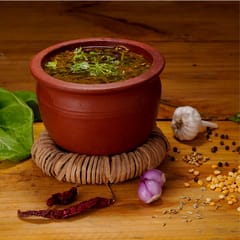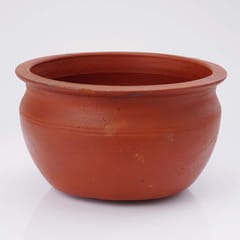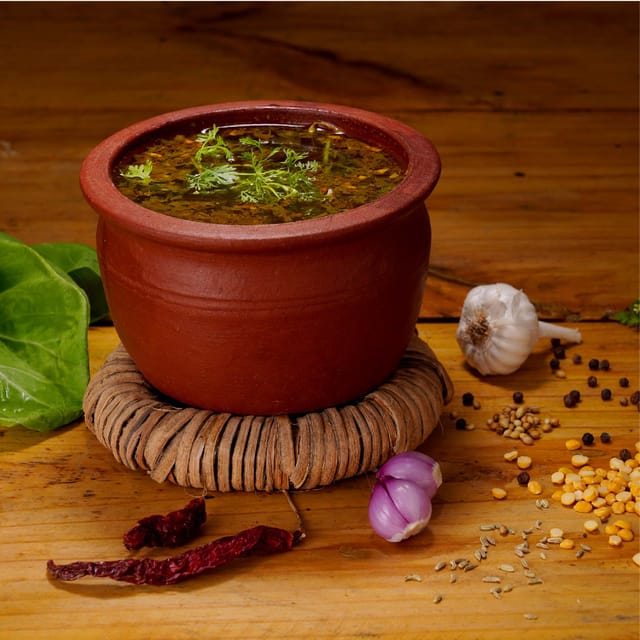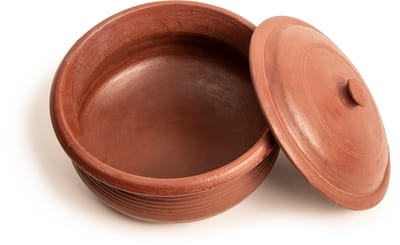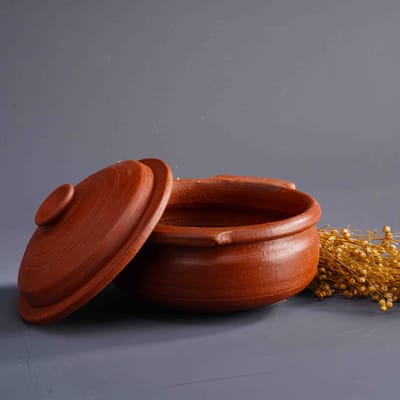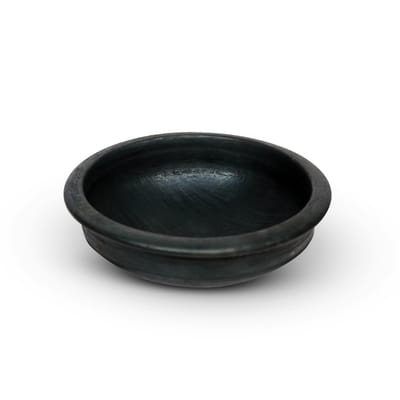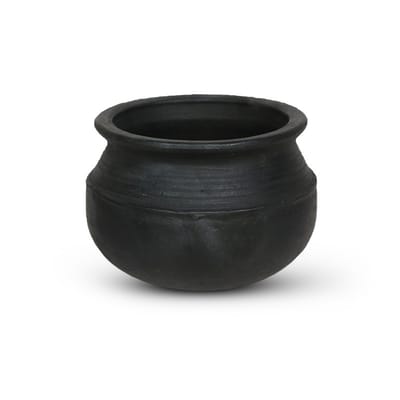Show cart summary 0 Items
Please Add Some Items
Rasam is derived from a Tamil word ‘irasam’ and the Sanskrit word ‘rasa’, both words meaning essence or extract. It is believed to have originated in the 16th century in Madurai by Sourashtras, an immigrant community. They prefer calling it ‘Pulichaar’ which means tart or tamarind.
Over the decades, the beloved Rasam came to be known by many names in South India. The dish is called Rasam in Tamil Nadu and Kerala, saaru in Karnataka, chaaru in Andhra Pradesh and saar in Maharashtra. Along with giving it a local name, every region also gave it its own twist to the flavour.
With 200 known varieties of Rasam, there are but minor differences in texture and flavour. Unlike, Rasam, saaru and chaaru have a thicker consistency with a touch of Saarina Pudi (a dry powder).
Benefits of Rasam Pot :
- This clay curry pot is made of fresh and natural clay locally available in the Palakkad region. No chemical is applied to make it smooth or shiny. It has all the goodness of the clay pots used by our grannies. So, it is a safe and healthy choice for all of us.
- Clay is somewhat porous so heat and moisture circulate through the pot, unlike metal & enamel pots therefore it is perfect for slow cooking without overheating. This helps to retain all the natural vitamins and minerals of the food. Clay pots add many essential nutrients like calcium, phosphorus, iron, magnesium and sulphur to food.
- Clay is alkaline in nature and neutralizes acidic food. Hence, clay helps in maintaining a healthy pH balance in the body and reduces common stomach problems faced by youngsters due to excessive consumption of fast food.
- Compatible with gas stoves, microwave ovens & traditional chulhas.
- Retains heat for a longer period. Thus keeping your food warm for a longer duration avoiding repetitive re-heating.
Health Benefits of Rasam:
The multiple health benefits of this dish can be decoded by examining certain ingredients used in it.
Often touted as ‘recovery food’, many grandmothers turned to Rasam as a home remedy to cure a cold and cough. Coriander seeds have anti-inflammatory properties. Meanwhile, ginger, turmeric and black pepper provide relief to sore throats and cold.
Adding raw garlic can help with circulatory ailments as well. Mustard and fenugreek are anti-oxidant.
Rasam comes in handy for people with digestive issues. Ingredients like cumin, ginger and asafoetida facilitate easy digestion and prevent constipation. Tamarind is rich in dietary fiber that eases bowel movement.
The many variants added in the Rasam together provide minerals such as zinc, calcium, niacin, potassium and magnesium. Not to forget, Rasam is also full of Vitamin A and C.
Finally, the black pepper can also speed metabolism that in turn helps in weight loss.
Now that you are aware of the several benefits of Rasam, go ahead cook this dish in Mudpots to enhance the taste and devour this simple delicacy that is a powerhouse of flavors.
How to Clean:
For general and deep cleaning, allow the earthen pot to soak overnight in the sink in water mixed with baking soda. Add 3 tablespoons of baking soda per liter of hot water. Wash the pot with a soft bristle brush or nonmetallic scrubbing pad. Do not use abrasive scouring powders because they will clog the pores and make the pot useless. Salt or ash can be used as a non-toxic alternative to chemical cleaners. Sprinkle salt/ash into the pot and scour it using a scouring pad. Rinse the pot with warm water and allow it to dry.
If any mold forms during storage periods sprinkle baking soda inside the pot, then rinse with warm water using a brush to remove the mold. If clay pores become clogged, the pot should be cooked in boiling water for about 30 minutes.
Never use soap or detergent because the porous nature of clay will absorb the soap. The detergent may leave an unpleasant soapy taste and this flavor will leach back into your next clay pot meal.
Storage:
After washing, make sure to store your earthenware in dry and well-ventilated areas. This will eliminate the risk of mold growth inside the pot.
If bacterial growth is of concern, dry the pots in a 200°F oven for 30 minutes before storing in a cool, dry place.
SKU-STYSGCYOARRQB- Home
- Mudpot
- Cooking pots
- Rasam Pot / Dal clay Pot
Rasam Pot / Dal clay Pot
- 1. 100% handmade product.
- 2. Retains heat for a longer period. Thus keeping your food warm for a longer duration avoiding repetitive re-heating.
- 3. Alkaline nature of clay neutralizes the acidity of the food and maintains the pH balance.
- 4. The porous nature of clay pot retains the moisture and aroma.
- 5. It's seasoned, so you don’t have to worry about any pre-processing.
- 6. It can be used to make all types of curries and side dishes.
- 7. It is a handmade product therefore size and shape may slightly vary.
- 8. Product does not include pot stand.
| VARIANT | SELLER | PRICE | QUANTITY |
|---|
Description of product
Rasam is derived from a Tamil word ‘irasam’ and the Sanskrit word ‘rasa’, both words meaning essence or extract. It is believed to have originated in the 16th century in Madurai by Sourashtras, an immigrant community. They prefer calling it ‘Pulichaar’ which means tart or tamarind.
Over the decades, the beloved Rasam came to be known by many names in South India. The dish is called Rasam in Tamil Nadu and Kerala, saaru in Karnataka, chaaru in Andhra Pradesh and saar in Maharashtra. Along with giving it a local name, every region also gave it its own twist to the flavour.
With 200 known varieties of Rasam, there are but minor differences in texture and flavour. Unlike, Rasam, saaru and chaaru have a thicker consistency with a touch of Saarina Pudi (a dry powder).
Benefits of Rasam Pot :
- This clay curry pot is made of fresh and natural clay locally available in the Palakkad region. No chemical is applied to make it smooth or shiny. It has all the goodness of the clay pots used by our grannies. So, it is a safe and healthy choice for all of us.
- Clay is somewhat porous so heat and moisture circulate through the pot, unlike metal & enamel pots therefore it is perfect for slow cooking without overheating. This helps to retain all the natural vitamins and minerals of the food. Clay pots add many essential nutrients like calcium, phosphorus, iron, magnesium and sulphur to food.
- Clay is alkaline in nature and neutralizes acidic food. Hence, clay helps in maintaining a healthy pH balance in the body and reduces common stomach problems faced by youngsters due to excessive consumption of fast food.
- Compatible with gas stoves, microwave ovens & traditional chulhas.
- Retains heat for a longer period. Thus keeping your food warm for a longer duration avoiding repetitive re-heating.
Health Benefits of Rasam:
The multiple health benefits of this dish can be decoded by examining certain ingredients used in it.
Often touted as ‘recovery food’, many grandmothers turned to Rasam as a home remedy to cure a cold and cough. Coriander seeds have anti-inflammatory properties. Meanwhile, ginger, turmeric and black pepper provide relief to sore throats and cold.
Adding raw garlic can help with circulatory ailments as well. Mustard and fenugreek are anti-oxidant.
Rasam comes in handy for people with digestive issues. Ingredients like cumin, ginger and asafoetida facilitate easy digestion and prevent constipation. Tamarind is rich in dietary fiber that eases bowel movement.
The many variants added in the Rasam together provide minerals such as zinc, calcium, niacin, potassium and magnesium. Not to forget, Rasam is also full of Vitamin A and C.
Finally, the black pepper can also speed metabolism that in turn helps in weight loss.
Now that you are aware of the several benefits of Rasam, go ahead cook this dish in Mudpots to enhance the taste and devour this simple delicacy that is a powerhouse of flavors.
How to Clean:
For general and deep cleaning, allow the earthen pot to soak overnight in the sink in water mixed with baking soda. Add 3 tablespoons of baking soda per liter of hot water. Wash the pot with a soft bristle brush or nonmetallic scrubbing pad. Do not use abrasive scouring powders because they will clog the pores and make the pot useless. Salt or ash can be used as a non-toxic alternative to chemical cleaners. Sprinkle salt/ash into the pot and scour it using a scouring pad. Rinse the pot with warm water and allow it to dry.
If any mold forms during storage periods sprinkle baking soda inside the pot, then rinse with warm water using a brush to remove the mold. If clay pores become clogged, the pot should be cooked in boiling water for about 30 minutes.
Never use soap or detergent because the porous nature of clay will absorb the soap. The detergent may leave an unpleasant soapy taste and this flavor will leach back into your next clay pot meal.
Storage:
After washing, make sure to store your earthenware in dry and well-ventilated areas. This will eliminate the risk of mold growth inside the pot.
If bacterial growth is of concern, dry the pots in a 200°F oven for 30 minutes before storing in a cool, dry place.

